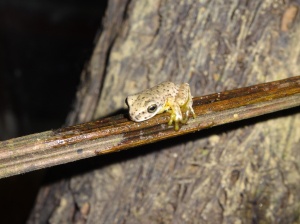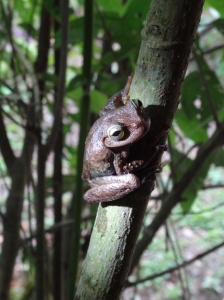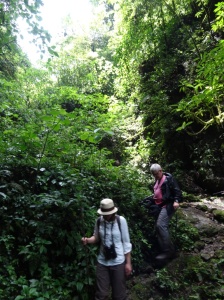It didn’t take long to recognise general patterns to the weather. While you might initially wake up to some mist lingering around the forested hills, this would clear up, and the mornings would subsequently be sunny and warm. I always enjoyed walking out on the northern side of the building; the large space with the raised roof revealed the scale of the hill in front of it.
It was in the afternoon that the sky would cloud over, and if any rain was coming that day, that was when it would turn up. Twilight was a particularly pleasant time, as there would be dozens of lightning bugs going off right outside the front door.
On the first morning, as on most subsequent mornings, we went for a walk in the hope of finding some ectotherm warming up in the first heat of the day. That morning, we hadn’t gone far before I spotted a lizard clinging to a tree; its head crest identified it as a Corytophanes, a helmeted iguana. Rowland was very pleased: we later confirmed it was a Corytophanes percarinatus, the first official record for this area!
After lunch, we set to work with the keys in Rowland’s amphibian and reptile books, identifying the specimens we had collected, both from the morning walk and the previous night. We confirmed two species of lizard, and three species of frog – all of the frogs were listed as critically endangered by the IUCN, which emphasised the importance of our work. This little spotted one is a young Plectrohyla quecchi, named after the local Q’eqchi’ people.
We had also spotted some rough-scaled Sceloporus taeniocnemis, but not captured any. These were relatively common around the campus but difficult to photograph; if you found one basking on a sunlit rock, you had to tread very carefully, as it would disappear as soon as it realised you were there.
That evening, we set out to put yesterday’s specimens back – and as so often happened in Las Guacamayas, we were distracted by new specimens! These included a large adult Lithobates maculatus, and a large tadpole which we eventually identified as L. maculatus too. The adult frog was originally stored in our bedroom that night, but we quickly realised we had to move it as it kept jumping around in the tank and keeping us awake.
Another walk after dinner revealed some particularly interesting frogs. One was the black-eyed tree frog Agalychnis moreletii, found in the same spot where the previous year’s survey had also come across it!
We identified two more of our finds as Plectrohyla hartwegi, which would represent a range extension for the species – and Plectrohyla teuchestes, distinctive by the green rims around its eyes, which had only been found in one other location! We had only just started, and already we had some important discoveries under our belt (if the IDs were correct).
On the morning of Day 3, we partook in something else we would be doing a lot of on this expedition: a photography session. In this case, our Corytophanes was the subject. While Rowland, Graeme and Kasper had more sophisticated equipment, I just had my little point-and-shoot; but I was at least able to study their technique and learn a lot in the process.
The morning walk didn’t reveal any herps – but sometimes, it’s the herps that come to you. Soon after we got back from our walk, Rowland was in the outdoor shower area when he noticed a small lizard on one of the beams. Some precarious climbing was required to reach it, but it was worth it: it was revealed to be a baby alligator lizard, Abronia gaiophantasma, which Rowland had really been hoping to find!
It was on our way to lunch on Day 4 – a group of local children were visiting for classes, and we were eating lunch in a separate building with them – we got our first snake! It was a familiar one from Las Guacamayas – the coffee snake Ninia sebae – but much bigger than any of those I had seen there.
The afternoon finally brought some real heavy rain – and that evening, we set out with a particular objective in mind: seeing whether any Rax k’aj would reveal themselves. Instead, we found a couple of opossums, and another familiar face: the blunthead tree snake Imantodes cenchoa.
On the evening of Day 5, we found our first salamander, Bolitoglossa rufescens. This salamander belongs to a successful group called the plethodontids, which are notable for having no lungs, and breathing entirely through their skin.
That evening, we had also gone out armed with sound recording equipment, in order to record some frog calls. Hanging around a stream area, the irregular chirping of glass frogs (Hyalinobatrachium) was audible even over the water. These glass frogs had also been seen on the previous survey, but for now they were up in the trees where we couldn’t see them; since we couldn’t identify their species for certain, we couldn’t add them to our list.
So far, many of our walks had involved some climbing around. A couple had taken us partway up the hills, where the slopes were steep and the forest was quite dense. Another trail featured a couple of uneven rocky climbs; when we followed this one all the way to the end, we found a stream with plenty of algae-covered rocks for us to clamber over! I was quite nervous for a lot of it, particularly when it came to coming down slopes – but I was handling it each time, with help from a bamboo walking stick, and boosting my own confidence as I did so. We were, however, about to try our longest and most challenging trail yet.



















The last pictured frog (the brown one wearing green eyeliner) looks like Gollum from Lord of The Rings.
LikeLike
It does, doesn’t it? It’s the fingers.
LikeLike